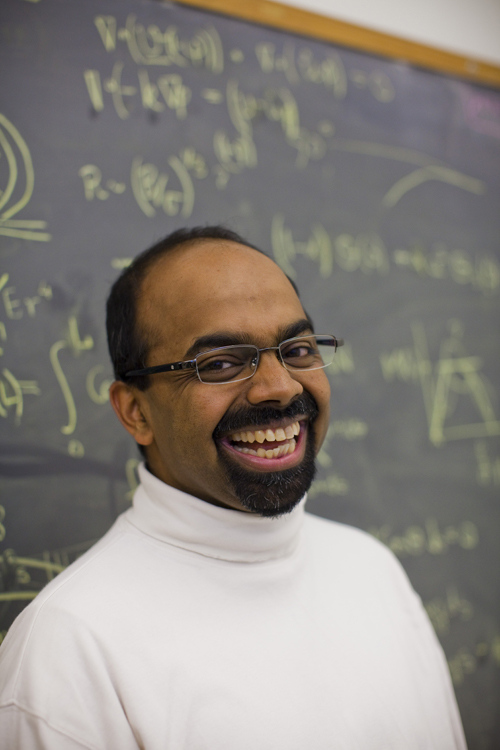PROVIDENCE, R.I. [Brown University] — Charles Darwin famously marveled at a living world filled with “endless forms most beautiful.” But can we ever truly understand how those endless shapes came to be?

L. Mahadevan believes we can — with the help of mathematics.
Mahadevan, professor of applied mathematics, physics, and biology at Harvard, will give a lecture titled “On Growth and Form: Mathematics, Physics and Biology” on Tuesday, Sept. 24, 2013, at 6:30 p.m. in Brown’s Salomon Center for Teaching. The event is part of a worldwide lecture series celebrating MPE2013 (Mathematics of Planet Earth) sponsored by the Simons Foundation, a private foundation with a mission to advance research in mathematics and the basic sciences.
The lecture will be hosted by Brown University’s Institute for Computational and Experimental Research in Mathematics (ICERM), one of eight federally funded math institutes in the nation. “The MPE2013 lecture series focuses on a broad range of themes having to do with the interactions between mathematics and the world, ranging from climate to health to sustainability, and to the mathematics of the natural world,” said Jill Pipher, ICERM director. “Events similar to this were held in Berlin, Melbourne, and San Francisco, and it is very exciting for ICERM and Providence to be part of this international portfolio of highly visible MPE venues.”
The mathematics of biological form
Mahadevan has studied the mathematics and mechanics behind a wide range of everyday natural phenomena — from how snakes slither, flags flutter or lilies bloom to how DNA is looped, cells are shaped, or guts coil. One emphasis of his work is to characterize biological shape in order to better understand how form feeds function.
“If you just go outside and look around, you see that living organisms have all kinds of complex shapes and complex dynamics. One could ask how did it come to be and why should one care,” Mahadevan said. “One reason is to try and link shape and form to physiology and function mathematically and perhaps eventually begin to tie in shape and form to evolution, as Darwin and many others since have tried to do.”
Mahadevan believes mathematics provides the tools to develop that kind of understanding.
“Mathematics is a language that allows you to quantify patterns in number, shape, and connectivity by compressing information into models that account for empirical facts, physical laws, and biological principles,” he said. “These models quantify assumptions, and following their consequences leads to testable predictions and the veracity of the assumptions. In that way, different kinds of mathematical approaches — different levels of models — allow us to describe, to predict, and in some cases to control.”
A major inspiration for Mahadevan’s work is a book written almost 100 years ago by D’Arcy Thompson titled On Growth and Form. Thompson wrote from the perspective of a mathematician but with a deep knowledge of biology, using analogy. “For example, in thinking about cell shape, he made a link to glass blowing, observing that the use of pressure and heat in different parts leads to beautiful glass blown objects,” Mahadevan said. “Certain cells, as they are being formed, use a very similar mechanism, but instead of heat they use enzymes to soften the wall. This analogy is a century old, but Thompson didn’t push it, beyond pointing out that similarity. Our work takes this to the next level by being quantitative and using experiments to flesh out the reasons.”
Mahadevan welcomes the opportunity to share his work and the power of math and science with a general audience.
“I think mathematics is the only language we really know that quantifies phenomena,” he said. “A lot of mathematics is more or less a quantified version of common sense. It’s particularly nice to get the opportunity to demonstrate this using different examples that pull together physical concepts and biological observations. I’m hoping that younger people will come because they are the future — and can solve the problems we find so hard today.”
Mahadevan received his Ph.D. from Stanford and was on the faculty at the Massachusetts Institute of Technology and the University of Cambridge before moving to Harvard in 2003. Among his awards are a Guggenheim Fellowship (2006) and a MacArthur Fellowship (2009-14).
Ticketing information for the talk is available at icerm.brown.edu/simonslecture. Additional information about MPE2013 is available at www.MPE2013.org.
